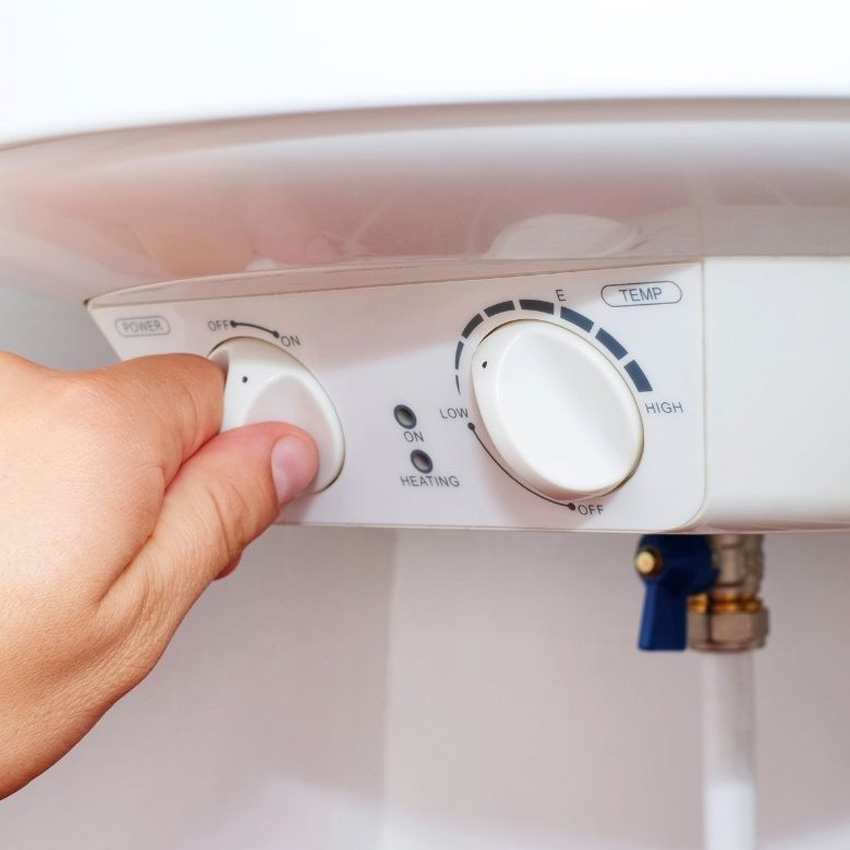In order to make sure your hot showers are hot and your clothes get washed, setting the right temperature for your hot water heater is key. Making sure the set temperature is correct will save you money on your utilities bill as readily as it will protect your family’s health.
Also, be sure to check out our hot water heater replacement service.
Why is the right hot water heater temperature important?
Having the right water temperature for your hot water heater is key. Not only does it ensure that you have a comfortable shower, it equally mitigates potential health risks that can occur if temperature is improperly set. At the bare minimum, set your water heater temperature to the safe range of 125-140 degrees F (up to 60 degrees C).
If your water heater’s tank temperature falls below the 120 degree F range, your tank is at risk of fostering the growth of bacteria. Because the water is stagnant and warm, it provides the perfect environment for bacteria to thrive: if the water isn’t hot enough to kill any organism that might grow inside, you risk putting yourself and your family in harm’s way with your bathing and drinking water.
One of the main risks with a water temperature that is too low is the chance of Legionella developing in your water heater tank. Legionella is a bacteria that loves warm water and when it is ingested by people (usually by being breathed in) it can cause Legionnaire’s Disease, leading to cough, fever, diarrhea, and worse – pneumonia. This disease can be found in portable water tanks, heaters, hot tubs, water fountains, and more where the temperature will consistently remain between 68 and 122 degrees F. With serious consequences, making sure your water heater is not set too low will allow you to mitigate the risk of Legionella and other bacteria forming in your water heating unit.
It is important to note that there is a misconception about how a water heater reads its temperature setting: the temperature set and read within the unit is not the output temperature at your point-of-use (a faucet, for instance) but instead the temperature of the water in the tank where the thermostat is located. The thermostat is usually located near the bottom of the tank close to the heating elements, meaning it is being exposed to a higher general water temperature and thus skews the reading of outgoing water.
This is important to note as your unit does not register the outgoing water and can potentially cause scalding risks at the point-of-use. In order to find the healthy balance between avoiding bacteria and avoiding scalding your family, it has become more common for water heater manufacturers to add thermostatic mixing valves to their water heating units. This allows for the water to become superheated in the tank and then mixed with cold water to achieve a safe temperature before it is shipped off to the shower head or faucet.
Factors in choosing your water heater temperature
There are a few factors to consider when setting your new water heater’s temperature. Working with your water heater technician and consulting the manufacturer’s notes of your new unit will allow you to precisely set an outgoing temperature that is comfortable, efficient, and safe.
Money-saving
-
- It’s no secret that water heating with a tank-based model is one of the biggest chunks of your utility bills. The constant heating and storing of your water can become inefficient and expensive if you don’t keep an eye on it. In order to lower your energy bill, consider lowering the temperature of your water heater: every 10 degrees F you go down represents savings of up to 5%. Over the long-term, those savings start to add up.
Groundwater Temperature
-
- When we talk about groundwater temperature we’re referring to the temperature of the water going into your home from your municipal or private water main. The temperature of the ground in your area will affect the temperature of the underground pipes and as such, needs to be considered when looking at flow rates and first hour ratings. For instance, someone in a colder region will have significantly colder water coming into their home.
- This means their water heater has to work harder in order to bring the temperature to what it was set at. This means more energy needs to be used and your water will have to be warmed more often in storage. Considering groundwater temperature is especially important for tankless hot water heaters, as the tankless models need to be able to rapidly superheat incoming water and thus the “temperature differential” ability of each model is important to look into.
Members of your household
-
- A safe and comfortable water temperature is partly relative to the person using the hot water. When you’re setting the temperature for your new water heater, consider who is using it: if the temperature is too hot, you might risk scalding the sensitive skin of children or elderly people (approximately 21 000 child injuries are caused by hot water taps in residential properties in the USA according to the American Burn Association). If the temperature is too low, bacterial growth that can occur might affect immunocompromised members of your household before they are noticed by anyone else. Make sure that your new water heater is set for your unique home, your family, and your lifestyle.
Relative hot water temperatures
-
- Certain appliances come with pre-heating mechanisms that will allow you to run a lower water heater temperature in the aim of saving energy and creating a more efficient hot water system. In appliances like dishwashers, these pre-heating mechanisms will read the temperature of incoming water from your water heater and then rapidly heat it within the dishwasher (usually via an electrical element). This allows the water to get to a temperature that will safely clean your dishes from any bacteria that might have lived on with a lower temp set by your water heater. The same can be said for laundry machines.
- In the inverse, installing thermostatic mixing valves for different points-of-use will allow you to have lower temperature output at places like showers and faucets where scalding can occur but still protects the tank from developing harmful bacteria. Talk with your water heater technician to see if thermostatic valves are the right call for you.
- Lastly, it is important to remember that a lower temperature in your tank results in you running out of hot water faster. This is because – in the example of a shower – more hot water needs to be mixed with cold water in order to achieve the desired temperature per your shower knob. If the outgoing temperature of your water from the hot water heater is high, you don’t need to use as much in order to get hot water in a bath or shower. Having a higher temperature in the tank will allow you to use less hot water as a whole.



